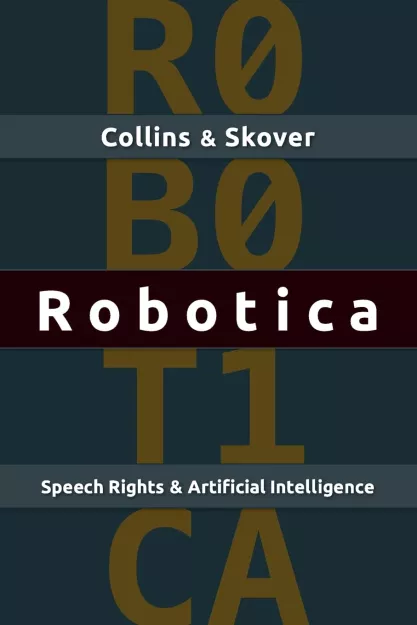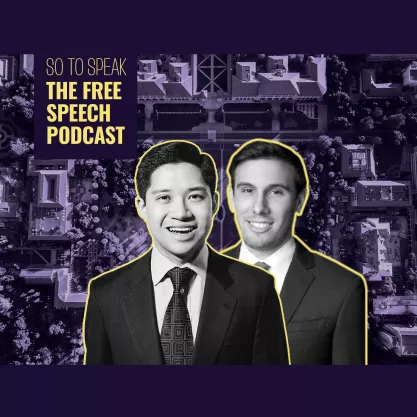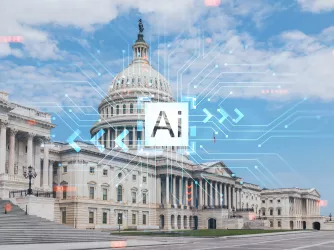Table of Contents
Artificial thinking in an age of artificial intelligence: Preliminary thoughts on the parameters of First Amendment jurisprudence — First Amendment News 374

Shutterstock.com
We live in a time when artificial intelligence (e.g., AI chatbots) is claiming more and more of the cognitive landscape of our daily lives. It requires us to examine how we think about our new world, one replete with great benefits and great challenges in a wide range of fields. Of course, such advances also prompt us to reflect upon limiting principles which, in the world of free speech, are known as censorship.
Mindful of such concerns, five years ago my colleague David Skover and I sketched out some preliminary thoughts on how to approach the evolution of First Amendment jurisprudence given the pervasive advances in communications technologies. Much of that thinking is more pertinent today as we move farther into the realm of communication “informed” by AI. Given that, we invite our readers to pause and begin to reconsider the parameters of First Amendment jurisprudence with due attention to our new communication technologies.
What follows is adapted from Collins and Skover, “Robotica: Speech Rights and Artificial Intelligence” (Cambridge University Press, 2018). Additional posts forthcoming.
The dawn of modernity
Modernity began with the printing press. It revolutionized the way people communicated, the ways they thought, the ways they worshiped, the ways they conducted business — that is, all the ways they interacted with the world around them. Yes, it was glorious, but it was also dangerous. After all, it ushered in a new set of harms largely unknown in the oral and scribal eras. Technologies do that, or at least the effective ones do. And when that occurs, censorship prepares to demand its due.

If the poet John Milton was a friend of the Enlightenment, then the polemicist Milton was also an enemy of the Church and its rule over the lives of its subjects. If he helped advance the cause of truth in the marketplace, his libertarian side made it possible for that truth to be fiercely attacked. If his notion of a free press pointed to its use in furtherance of the rule of law, the radical in him defended the killing of the king. And if high values took refuge in his thought, low ones (such as his defense of divorce and polygamy) found sanctuary in his writings. Little wonder, then, that he coined the word “pandemonium.” This chaos — the good, the bad, the blessed, and the profane, all warring — was intensified by print, the medium he championed with poetic passion. Hence, if his defense of that revolutionary technology pointed to a utopia of freedom, it likewise brought with it a “Paradise Lost,” the toppling of the status quo. Only recall how William Blake judged him: Milton was a member “of the Devil’s party.”
Now consider this passage from “Areopagitica” (1644): “And as for regulating the press, let no man think to have the honor of advising ye better than yourselves.” By that measure, no truth, no gospel, no norm was safe from Milton’s cherished “perpetual progression” and his lifelong attacks on “conformity and tradition.” That mindset and those attacks fueled his defense of the printing press. Our point: any new and effective technology of communication changes the calculus of values while recalibrating our notions of harm.
Just as Milton’s beloved printing press had great value and utility, so too does communication amplified by artificial intelligence. And much as print brought with it new dangers, the same is and will be true of AI communication. How we navigate those waters of harm is uncertain; that such communication will become ubiquitous is not. Will there be, in Milton’s words, some cultural and legal “pandemonium”? Of course.
The evolutionary principle
Evolution does not respect constitutions, customs, or creeds. It washes over them like waves erode shorelines. Beyond metaphorical messages, what does that mean? It means that we must approach AI communication with a certain open-mindedness, a preparedness to question our presuppositions, and a willingness to embrace, however guardedly, what seems inevitable. That is, the inevitable may not always be in sync with today’s view of the law — or even with today’s understanding of what it means to be a communicative human being.
Know this: AI communication will produce new and dizzying paradoxes in the law of free speech.
The crisis of modernity
Modernity never grows old. This explains why there will always be some “crisis of modernity,” ad infinitum. When we think in such terms, names like François-Marie Voltaire and Denis Diderot, or more recently Michel Foucault and Jean Baudrillard, spring to mind. But we might as well think of Johannes Gutenberg (Western inventor of the printing press), Tim Berners-Lee (inventor of the internet), or Martin Cooper (inventor of the handheld cellular mobile phone).

Technologies — more specifically, communications technologies — are inextricably linked to an ever-evolving modernity. Thus, there will always be some “crisis” swirling around them. And why is that so?
The communication mechanisms impact how we think about, interact with, and influence the law of free speech governing them. Whenever a profoundly new communication technology emerges, it profoundly affects our comprehension of the world and our communication of knowledge, and eventually our legal efforts to govern it. Both benefits and harms are blended in the crucible. Moreover, in the process, the very notions of benefit and harm are reconfigured.
A philosophy of technology
Mindful of such matters, one can sense something of the subterranean side of what we offered up in our book, “Robotica.” That something might be understood as a philosophy of technology, a more wide-ranging way of thinking about life and law. Given how vital technology is to culture and how it dominates it in so many ways, a philosophy that speaks to such concerns would seem natural. But that is hardly the case, and it is certainly not the case when it comes to legal philosophy.
Ironically, this absence is even more striking when one considers how technology impacts our conceptions of knowledge and truth — matters central to the First Amendment. To be sure, much more would need to be said to give real and full significance to this seedling of a philosophical point. For now, however, we trust that what we have outlined in “Robotica” concerning the architectonic qualities of technology will suffice to indicate that there is more at stake here than law alone, even constitutional law. This raises a related and final point in our abbreviated ruminations here.
The need for artificial thinking
Artificial. It is what humans, rather than what God or nature, create. It is our mortal contribution to existence. Think of it as our attempt to be God-like. In that sense, it is both presumptuous and wondrous. If more and more of our modern collective intelligence tends toward the artificial, it is because it is all too human to do so. It is, if you will, our Promethean predisposition. By that mythological gauge, we ask: Will the free-speech jurisprudence of the future be bound or unbound? Probably more the latter. If so, hail Prometheus!
Related
- Michael R. Siebecker, “The Incompatibility of Artificial Intelligence and Citizens United,” Ohio State Law Journal (2022)
- Alan Z. Rozenshtein, “ChatGPT and the First Amendment: Whose Rights Are We Talking About?” LawFare (April 4)
- Benjamin Wittes, “A Machine with First Amendment Rights,” LawFare (March 31)
- Gonzalez v. Google [Whether Section 230(c)(1) of the Communications Decency Act immunizes interactive computer services when they make targeted recommendations of information provided by another information content provider, or only limits the liability of interactive computer services when they engage in traditional editorial functions (such as deciding whether to display or withdraw) with regard to such information.]
- Ronald Collins and Ryne Weiss, “Censoring the technologies of free expression,” FIRE (Oct. 19, 2022)
- Nico Perrino, Alison Schary, Eugene Volokh, and David Greene, “‘So to Speak’ podcast transcript: Artificial intelligence: Is it protected by the First Amendment?” FIRE (Jan. 26)
- James B. Garvey, “Let’s Get Real: Weak Artificial Intelligence Has Free Speech Rights,” Fordham Law Review (Dec. 2023)
- Eugene Volokh, “Large Libel Models? Liability for AI Output,” UCLA Law (March 27)
- Eugene Volokh, “Large Libel Models: The CheckBKG Analogy,” The Volokh Conspiracy (April 3)
Forthcoming book on regulation of digital industries
- Mark MacCarthy, “The Regulation of Digital Industries: How Public Oversight Can Encourage Competition, Protect Privacy, and Ensure Free Speech,” (Brookings Institution Press, Oct. 15, 2023)

The Regulation of Digital Industries is the first book to address the tech backlash within a coherent policy framework. It treats competition, privacy and free speech as objectives that must be pursued in a coordinated fashion by a dedicated industry regulator. It contains detailed discussions of current policy controversies involving social media companies, search engines, electronic commerce platforms and mobile apps. It argues for new laws and regulations to promote competition, privacy and free speech in tech and outlines the structure and powers of a regulatory agency able to develop, implement and enforce digital rules for the twenty-first century.
Deeply informed by the history of regulation and antitrust in the United States, it brings to bear insights from the breakup of AT&T and the Microsoft case and from broadcasting and financial services regulation to enrich the discussion of remedies to the failure of tech competition, the massive invasion of privacy by digital firms and the information disorder perpetuated by social media platforms. It offers a comprehensive summary of regulatory reform efforts in the United States and abroad and shows how accomplishing the goals of these reform efforts requires the establishment of a single digital agency with jurisdiction to reconcile and balance the complementary and conflicting goals of promoting competition, protecting privacy, and preserving free speech in digital industries.
It discusses in detail how a digital regulatory agency would be structured and the powers it would need to have. It confronts head on some of the challenges in establishing a strong digital regulator including the First Amendment roadblock that limits government authority over digital speech and the judicial opposition to the expansion of the administrative state. It is essential reading for policymakers, public interest advocates, industry representatives, academic researchers and the general public interested in a coherent policy approach to today’s tech industry discontents.
Dan Shelley on televising Trump trial
- Dan Shelley, “Trump’s criminal court proceedings must be televised,” The Hill (April 4)

The once unthinkable has now happened. A former president of the United States was indicted on criminal charges in New York City. The Justice Department and Georgia prosecutors are investigating at least three other cases that could also lead to prosecutions.
Now, it’s time for another once unthinkable development: The Trump criminal court proceedings must be televised.
Currently, video and audio coverage of trials in New York City Criminal Court, where he being arraigned Tuesday, and in New York City Supreme Court, where any trial would almost certainly take place are rarely, if ever, allowed.
Permission must be granted in this historic case.
Should the Fulton County, Georgia, investigation into the former president lead to an indictment and court proceedings, Georgia rules do allow for video, audio and livestreaming, as they should.
Dan Shelley is the president and CEO of the Radio Television Digital News Association.
New scholarly article on free speech and abortion
- Raymond Shih Ray Ku, “Free Speech & Abortion: The First Amendment Case Against Compelled Motherhood,” Cardozo Law Review (2022)

The most important lessons are taught by example. Children learn the fundamental values that guide them throughout their lives from the examples set by their parents, especially their mothers. Before and after they understand language, they learn by observing and imitating the actions of their parents. For almost fifty years, Roe v. Wade guaranteed pregnant women the freedom to determine whether to carry their pregnancy to term. The right to obtain a safe abortion prior to viability is the most significant and controversial aspect of this freedom.
The Supreme Court is now poised to overturn what it previously described as the central holding of Roe and allow state governments to restrict abortions prior to viability. If this occurs, it will not be because of an erosion of precedential authority. Instead, it will result from decades of concerted efforts to pack the Supreme Court with Justices who reject the premise that the substantive due process guaranteed by the Fourteenth Amendment limits the power of the states. Whether the Fourteenth Amendment independently restricts the power of states to regulate abortion, however, is not the focus of this essay. Instead, this essay argues that parallel developments in First Amendment law not only reinforce the traditional justification for safeguarding a woman’s freedom to determine whether to continue a pregnancy, but provide an independent justification for subjecting abortion restrictions to heightened judicial scrutiny.
Over the past fifty years, Justices that would restrict the Fourteenth Amendment’s role in guaranteeing individual liberty have successfully argued for a greater role for the First Amendment. Government regulation of conduct, especially commercial conduct, previously not recognized as protected speech has increasingly been subject to heightened judicial scrutiny and, in some cases, categorical protection.
This essay examines two recent cases, Masterpiece Cakeshop v. Colorado Civil Rights Commission and Sorrell v. IMS Health, Inc., in which the Justices were required to consider whether the First Amendment and its protection of speech applied to conduct that would not traditionally have been considered speech. These cases highlight both the substantive and strategic value of (re)considering the myriad ways in which conduct is expressive or otherwise integral to expression and the nature of judicial review. When applied to abortion, this line of reasoning illuminates the expressive values at stake with pregnancy and childbirth; why abortion restrictions must be carefully scrutinized to ensure that they do in fact promote a legitimate interest in protecting the welfare of mother and child; and the need to prevent governing majorities from using childbirth to endorse and celebrate moral beliefs that are not shared by the pregnant woman and may be antithetical to her interests and the interests of a child.
‘So to Speak’ podcast: David Lat on Stanford controversy
- Nico Perrino and David Lat, “The Stanford shout-down with David Lat,” FIRE (March 22)

UPDATE: Just as this podcast was to be published, Stanford Law School Dean Jenny Martinez sent a 10-page memorandum to the law school community outlining a path forward for the school, including updating school policies to prevent future speaker disruptions and mandatory student free speech training. She also announced that Associate Dean Tirien Steinbach is on leave.
The heckling began almost as soon as Fifth Circuit Court of Appeals Judge Kyle Duncan started his invited lecture at Stanford Law School on March 9. Signs in the audience read “RESPECT TRANS RIGHTS,” “FEDSUCK,” “BE PRONOUN NOT PRO-BIGOT.” What transpired over the next 40 minutes captured national headlines and raised questions about the state of free speech at America’s law schools.
David Lat writes commentary about law and the legal profession for Original Jurisdiction. Until 2019, he was an editor at the legal news website Above the Law, which he founded. Prior to his journalism career, David was a practicing lawyer.
Related
- Cameron Ehsan, “Stanford president renews commitment to academic freedom amid law school controversy,” The Stanford Daily (April 3)
- Ronald Collins, “Heckler’s veto in raucous play at Stanford Law School, federal judge’s speech shouted down,” First Amendment News (March 10)
More in the news
- Eugene Volokh, “Florida Libel Law Reform Bills, Post 1: The Challenge to New York Times v. Sullivan,” The Volokh Conspiracy (April 3)
- “School district sued over axing of student newspaper after LGBTQ issue,” The Free Speech Center (April 3)
- Susanna Granieri, “Jury to Decide if Fox Knowingly Spread False Information About Dominion, Delaware Judge Rules,” First Amendment Watch (April 3)
- “Elie Mystal on Tennessee’s Anti-Drag Ban: GOP Is Pushing Bigotry & Attacking the First Amendment,” Democracy Now (April 3)
- Fred Barnes, “His obsessive online posts terrorized her. But were they illegal threats?” The Washington Post (April 1)
- Ashley Mackin-Solomon, “La Jolla group seeks high-level input from S.D. on how to curb ‘so-called First Amendment’ sidewalk vendors,” La Jolla Light (April 1)
- Eugene Volokh, “Ban on Knowingly False Statements During Emergencies Struck Down on First Amendment Grounds,” The Volokh Conspiracy (March 31)
- Jeremy W. Peters and Katie Robertson, “Fox News Suffers Major Setback in Defamation Case,” The New York Times (March 31)
- Susanna Granieri, “Key Takeaways of Supreme Court Oral Arguments in United States v. Hansen,” First Amendment Watch (March 29)
- Jeremy Barr and Kyle Melnick, “Fox News media analyst says network won’t let him cover Dominion lawsuit,” The Washington Post (Feb. 27)
- Stephen Lemons, “Woodhull’s FOSTA Challenge Lays Bare DOJ’s Lies in Lacey/Larkin Case,” FrontPage Confidential (Jan. 17)
2022-2023 SCOTUS term: Free expression and related cases
- 303 Creative LLC v. Elenis (argued Dec. 5)
- Jack Daniel’s Properties, Inc. v. VIP Products LLC (argued March 22)
- United States v. Hansen (argued March 27) (Volokh commentary here)
- Counterman v. Colorado (to be argued April 19)
Pending petitions
- Frese v. Formella
- National Rifle Association of America v. Vullo
- Mobilize the Message v. Bonta
- Vidal v. Elster
- O’Connor-Ratcliff v. Garnier
- U.S. v. Hernandez-Calvillo
- Price v. Garland
- Moody v. NetChoice, LLC
- NetChoice, LLC v. Moody
- Florida v. NetChoice
- Klein v. Oregon Bureau of Labor and Industries
State action
Qualified immunity
- Novak v. City of Parma (cert. denied)
Immunity under Foreign Sovereign Immunities Act
NSO Group Technologies Limited v. WhatsApp Inc. (cert. denied)
Liability Anti-Terrorism Act
- Twitter v. Taamneh (argued Feb. 22)
Section 230 immunity
- Gonzalez v. Google (argued Feb. 21)
Review denied
Previous FAN
FAN 373: “Stanford’s Gerald Gunther warned against campus limits on free speech three decades ago”
This article is part of First Amendment News, an editorially independent publication edited by Ronald K. L. Collins and hosted by FIRE as part of our mission to educate the public about First Amendment issues. The opinions expressed are those of the article's author(s) and may not reflect the opinions of FIRE or of Mr. Collins.
Recent Articles
FIRE’s award-winning Newsdesk covers the free speech news you need to stay informed.

FIRE to defend veteran pollster J. Ann Selzer in Trump lawsuit over outlier election poll

FIRE’s defense of pollster J. Ann Selzer against Donald Trump’s lawsuit is First Amendment 101

FIRE statement on legislative proposals to regulate artificial intelligence


